We rarely take much note of mushrooms that crop up in the dirt. Drawing on his locale, Abdul Basith shows how mushrooms, in fact, shape and reshape the relationships between people, property and nature.
Abdul Basith
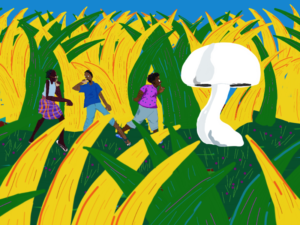
During the monsoon seasons, Kerala experiences heavy thunder and lightning. At this time, there is a peculiar kind of thunder, frequent and modest-sounding, often called colloquially as kumil idi or koon idi, which can be roughly translated as ‘thunder which causes mushrooms to sprout’. Mushrooms and thunders are companions in folklore across the world. Japanese farming folklore, for example, shares the same idea—that lightning multiplies mushroom growth. A study by Japanese scientists indicates that this lore has some truth behind it (Robbins 2013).
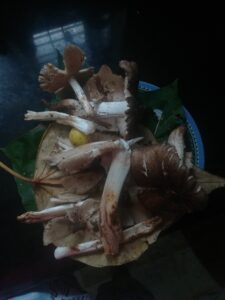
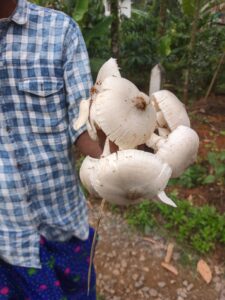
Mushrooms are of great importance in Kerala’s Adivasi populations’ food baskets, and our knowledge about edible and non-edible species of mushrooms comes from Adivasi communities. From my personal experience, people in rural Kerala, in general, are able to identify mushrooms by their size, shape, toxicity, colour, and for some, even by smell. Even within rural communities, daily-wage labourers at farms and plantations have more knowledge about medicinal properties and species varieties, much like Adivasi communities—as we shall see, this knowledge is profoundly shaped by class, caste, and other dynamics. Adivasi communities are informed on an even wider range of features, and consume a wide variety of specifics. Non-Adivasi communities in Wayanad consume mainly two kinds of mushrooms, which are visually distinct. One is called ari kumil (rice mushroom) or podi koon (tiny mushroom), which is smaller and tender, and sprouts in large numbers over an area. The other variety, pa kumil (milky mushroom), is bigger in size, and can be found isolated and scattered across an area.

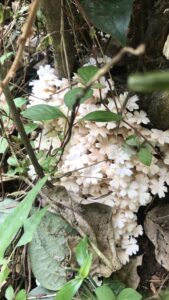
There are mushrooms of several varieties, but I focus here on the knowledge, perception, and economic norms around mushrooms that grow naturally in soil. They have an earthy smell and peculiar taste lacking in cultivated mushrooms which can be purchased from stores and cultivators. The foraging, use, and traditional knowledge of wild mushrooms, which originates from Adivasi communities, are also shared with non-Adivasi communities that live in close association with them, like the Mappila Muslim community to which I belong. In this piece, I draw upon the insights of Adivasi acquaintances from Wayanad, especially from my locality. I also reflect upon my memories and family anecdotes to explore the complex economy of mushrooms.
Embodied and Vanishing Knowledges
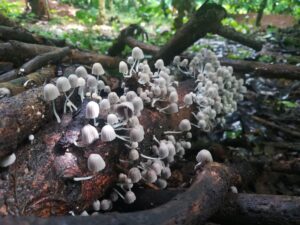
An incident involving a relative of mine explains the knowledge gap between Adivasis and non-Adivasi communities regarding mushrooms. Once, my relative’s neighbour from Calicut visited us in Wayanad, and after having wild mushrooms with us for the first time, he was impressed with their taste. The following week, he tried mushrooms that grew in his own homestead, and he was hospitalised due to intoxication. Being from a coastal fishing community, he was unable to differentiate between edible and toxic mushrooms.
Researchers have observed that rather than being universal biological traits for all humans, sensorial experience/knowledge comprising sight, hearing, taste, touch, and smell is constructed culturally and shared through social groupings and bonds (Porcello et al. 2010). The relationship between humans and nature is mediated by environmental, biological, and cultural factors. Traditional ecological knowledge around wild mushrooms, therefore, is a result of human-nature interactions. It is the culmination of wisdom, practices, and beliefs passed down generationally (Berkes et al. 2000). As ‘magic mushroom hunts’ trend on social media, it is important to remember that being adventurous about mushrooms without paying heed to long-standing local knowledge about them is a dangerous combination, especially with the decline in the growth of indigenous knowledge due to urbanisation. As a popular saying among mushroom hunters of Europe warns us, ‘There are old mushroom hunters, and there are bold mushroom hunters, but there are no old, bold mushroom hunters’ (Keough 2020).
Much of the embodied knowledge around mushrooms takes the shape of myths and beliefs around mushroom picking. Thurumbettan, an elderly member of the Paniya community (Adivasi) who is an ardent mushroom enthusiast, said, ‘Mushrooms have to be collected without making noise around them. If this is followed, the person can reap mushrooms for days in a row’. Another mushroom picker, Saleem, observed, ‘If you are disciplined while plucking mushrooms, you can reap for three consecutive days. Don’t rush and make it a mess. If you talk around them, mushrooms won’t sprout there’. Shaji, a farming contractor living next to Thurumbettan, has a different view on the unwritten rule of not talking: ‘It’s a precaution against other pickers noticing you, unrelated to the crop’s sprouting and availability.’
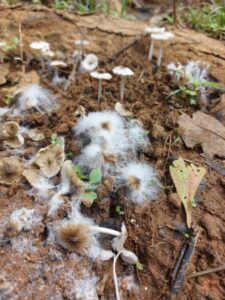
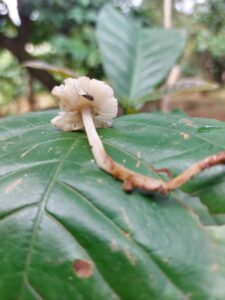
Foragers know where mushrooms sprout each year by date and area. I, too, have found mushrooms in the same area on the same date in consecutive years. As a reminder, my mother used to note down the dates on the calendar in the kitchen. Mushrooms have to be reaped as soon as they sprout—otherwise, they start to rot and become inedible. Insects and worms swarm mushrooms as soon as they start rotting. Thurumbettan observes that exposure to sunlight starts to rot the mushroom. As a precaution, the mushroom is sauteed with turmeric and salt to ward off its toxic elements; toxic mushrooms turn blue in turmeric water.
An important sensorial aspect of mushroom picking is the smell—the smell of mushrooms is harder to pick for an unfamiliar nose. I am reminded of an incident which shocked and intrigued me as a kid. We were playing cricket on the public road in front of my home. A neighbour from the Paniya community was walking towards us on his way to town. All of a sudden, he turned his head, and as if in reflex, leapt and plucked a mushroom from another neighbour’s land boundary. The children who witnessed this were in awe. When I told my mother, she explained that Adivasis are proficient in finding mushrooms with just a distant smell. Notwithstanding the exotic narratives and stereotypes developed towards Adivasi communities by non-Adivasis, this was yet another instance of how ecological knowledge was shaped and how ideas about authentic knowledge circulated within a locale.
Later, I learned that not everyone can pick up the smell of mushrooms from a distance, and that there are quite a few good noses in my neighbourhood who can pick it up easily. Ummer, over 60 years old, who is known for his skill in finding mushrooms, said, ‘Every mushroom has its own distinct smell. Not everyone has the skill of smell; it is a blessing’. While speaking of mushrooms, Ummer waxed poetic, and his eyes sparkled with excitement. He said, ‘Pa kumil [milky mushroom] shines white, and it’s easy to find at night. The mushroom is adorned with a white aura and beckons mushroom pickers with its smell. More than the joy of eating mushrooms, I love the process of picking’.
In my conversations, it became clear that these embodied skills and narratives are fast disappearing. Changing weather, irregular rain patterns, and changing agricultural practices have affected mushrooms too. Ammini, who migrated to Wayanad in the early 80s with her husband for a job and lives in the Ooramkunnu colony, lamented about the changing weather, saying that kumil idi or mushroom thunders are fake thunders because they have not led to significant mushroom growth for the past few years.
Komala observes that the short-term heavy spells of rain brought about by climate change are soaking the mushrooms, which withers them away. Asees, an agriculture worker known for his skill in finding mushrooms, says, ‘If people continue to clear weeds with Roundup [a chemical weedicide] there won’t be any mushrooms here. So whenever I am told to clear weeds from gardens or plantations, I insist on clearing manually with a sickle or mechanised weed cutter. Talking about mushrooms with the people who lived around me gave me a glimpse into the complex interplay of sensorial experience, knowledge, changing human-nature relations, and the lived experience of local and indigenous populations.
Ownership – Between Foraging and Private Property
Komala lives with her grandchildren in Ooramkunnu colony. This is also where Thurumbettan lives—a settlement inhabited by Muslims, Dalits, and Adivasi communities where most are landless and a few have small land holdings. During picking season, Komala’s whole family, except those who can’t walk, goes for mushroom hunts in the early hours. Whenever there is a surplus, it is shared with neighbours and acquaintances, and the rest is sold as per demand. By midnight, the foragers enter into lands where they expect to find the most mushrooms. Upon seeing a sprout, they cover it with leaves to protect it from sunlight and other foragers, especially the owners of the land.
Mushroom foraging is a seasonal practice of monsoons among people who are fond of it. When it comes to mushrooms, the practice of foraging and the privatisation of land together create unique paradoxes of time, space, and value. Among the mycophiles (mushroom lovers), mushrooms are highly desired and also rare. While such a scarce resource would invite rivalry and competitiveness according to existing norms of private property, such conventional norms are blurred in the case of mushrooms. The unwritten law with mushrooms where I live is that they belong to the person who finds them, and a portion is often gifted to the owner of the land. The agency to gift a commodity belongs to its owner (here, the finder), and this gifting serves as a reciprocal gesture, expressing appreciation for the landowner’s hospitality in granting access to their property.
By taking advantage of this de facto rule, I have seen many of my acquaintances and neighbours like Komala and her family walking around private lands and plantations in search of mushrooms. This is quite unusual in my rural community, where I have observed instances where individuals engage in disputes and cultivate animosity over various issues of land ownership—picking cash crops like coconut, mango and other forest products, water sharing, and the trespassing of hens and goats across boundaries. One such case of a heated argument between my father and some Adivasi women in the neighbourhood highlighted the exceptional status of mushrooms in our rural economy. My father was more fond of mushrooms than anything, while mangoes came next. The matter of debate was about who found the mushroom first, rather than to whom it normally belongs as per land ownership norms.

The communal rules around mushrooms confirm what eminent political scientist and economist Elinor Ostrom observes: that communities develop their own rules, norms, and institutions over time to govern the use of common resources. These rules are often shaped by the collective knowledge and experiences of the community members. By organising themselves, communities can create systems that promote sustainable resource utilisation, prevent overexploitation, and minimise conflict (Ostrom 2015). The enduring community norms around mushrooms, therefore, give us a glimpse into a model of resource sharing that exists in tension with private property.
According to Saleem, a farmer, the finder-owner relationship with respect to mushrooms is also beginning to conform to conventional land ownership norms as wild mushrooms are dwindling, and as the relationship between people becomes weaker. In general, we can see that landowners dictate the norms of trespassing upon their property. While trespassing for mushrooms is valid, trespassing for cash crops like coconut is invalid. Here, the rules are set by the power holder, essentially the landowner. The rules and exceptions around foraging and property rights in the community are decided as per caste-ridden logic and the pragmatic considerations of those in power.
So one might ask: even within a private property regime, how does mushroom continue to be treated as a common property, especially considering the scarcity and seasonality of mushrooms? The answer might lie in the unique nature of mushrooms themselves as organisms. Firstly, mushrooms are delicate and ephemeral—they have a low shelf life and only stay fresh for a day or less once sprouted, and have to be picked before the sunlight hits, since insects start feeding on them. Heavy rains would drench them within half a day. Secondly, it is difficult to know exactly when mushrooms sprout, though it is generally known they crop up during the monsoon. Clues like smell and mushroom thunders give cues to expect mushrooms, but these are not definite. Hence the continued reliance on the intergenerational sensorial knowledge possessed by Adivasi communities and others. Lastly, as Asees, an agricultural labourer, pointed out to me, wild mushrooms are not cultivated, hence there is no cost. It sprouts without human intervention. Like the fish in the river, it remains common property, even while land is a private property. These constraints push people to be tolerant about trespassing so that the mushrooms might be utilised rather than wasted. Further, the owners get a share of mushrooms which otherwise would be perishing without knowledge of its sprouting time.
Loaded Perceptions
Mushrooms are perceived through a spectrum of affection, ranging from love to hate. These positive or negative feelings are not generally value-judged because they are part of the culture of a given social group (Ruan-Soto et al. 2013). Different communities within Wayanad have varied relationships with mushrooms. The Jains, strictly, and Brahmins, at large, follow vegetarianism. Jainism professes non-violence (ahimsa) and rejects Vedic scriptures. The notion of daya (compassion) towards all living beings is also a principle associated with ahimsa. Jains manifest ahimsa more vigorously with food habits, even with microorganisms (Thompson & Kaplan 2014, 1299). When asked about mushrooms, an elderly Jain woman said, ‘We are vegetarians, we won’t eat mushrooms’. Upon noticing a cow in their yard, I further asked, ‘How about cow milk?’
‘Yes, we do consume that, we need nutrition, right?’
‘Then how about eggs?’
‘No, it’s non-vegetarian.’
I enquired further about onions with people of the Jain community in my locale, and they brought up the pollution logic to argue that since human excreta is used as manure for onions, they avoid it. Ashok Kumar from the Jain community said, ‘I can identify the mushrooms, but we don’t eat it. Our workers from farms and coffee plantations used to collect it, and take it to their homes’. I then asked, ‘Do you eat onions?’ He replied with a negative connotation, using a ‘scientific’ explanation: ‘Yes, we do eat onions nowadays, but not mushrooms, since mushrooms carry a lot of germs, don’t they? We use onions and yams occasionally, but in a higher stage of spirituality we will have to avoid those too.’ Yashodaran Gowda further explained, ‘We practise ahimsa, hence we avoid harming even small organisms. We don’t eat mushrooms, and I think it is due to dietary restrictions on eating organisms which come out of decaying matter, even though it is like a plant’.
As is evident here, food is a lens to understand racism and casteism in India. Power dynamics and intellectual reasoning that create and perpetuate beliefs of superior and inferior food cultures are founded on caste (Kikon 2022, 281). In the case of mushrooms, we can observe how a sense of purity/pollution essentialised by Brahmanical logic is employed to defend and to hold a moral high ground. The purity logic is predominantly a product of casteist sensibility parading as concern about hygiene. The terms ‘cleanliness’ and ‘purity’ are used interchangeably and seem innocent, but the notion is casteist. The recent controversy sparked by billionaire Sudha Murty is also an example of such casteist sensibilities.
Conclusion – Ephemeral Mushrooms, Enduring Injustice
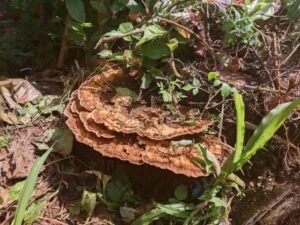
These fleeting and intangible perceptions, anecdotes, intuitions and sensorial knowledges weave together to form the political economy of mushrooms. Far from being ephemeral, it is shaped by long-term and complex historical, socioeconomic, and environmental factors—a series of events that have shaped land ownership and indigenous rights. Throughout history, the dominant-caste feudal class, British colonial rule, and the subsequent post-independence environmental conservation regime have all collectively contributed to the violent invasion of Adivasi lands. This invasion was further intensified by the influx of migrant settlers from Travancore into Wayanad between the 1930s and 1970s. As a result, there has been a chaotic history of land dispossession and encroachment, leading to the marginalisation of Adivasi communities and the disruption of their traditional ways of life (Münster & Vishnudas 2012, 40-41). Adivasis like Thurumbettan have been forced into ghettos as their lands were increasingly privatised. When I spoke to Dr. Suma T R, an anthropologist from Wayanad, she said that these evicted Adivasis settled in unproductive and flood-prone areas of Wayanad. Many places in Wayanad ending with poyil are examples of such areas.
This long history of dispossession and marginalisation contrasts sharply with the romanticised narratives expressed by urban-landed individuals who lament the disappearance of biodiversity and the natural landscape. What often goes overshadowed in these nostalgic tales is the significant role played by historical injustice in destroying the environment. The disappearance of nature is not solely a natural phenomenon but is closely tied to the legacy of land alienation suffered by Adivasis. To move towards an equitable and sustainable future, we must understand the intricate interplay between historical legacies and contemporary practices.
References
- Berkes, F., Colding, J., & Folke, C. 2000. ‘Rediscovery of Traditional Ecological Knowledge as Adaptive Management’. Ecological Applications 10, no. 5.
- Bopegamage, A., & Kulahalli, R. 1971. ‘Sanskritization and Social Change in India’. European Journal of Sociology/Archives Européennes De Sociologie 12, no. 1.
- Keough, B. 2020. ‘Here’s What You’ll Need to Start Foraging Mushrooms’. The New York Times, 13 July 2020. Retrieved August 4, 2023, from
- Kikon, D. 2022. ‘Dirty food: racism and casteism in India. Ethnic and Racial Studies 45, no. 2, 278–297.
- Münster, U., & Vishnudas, S. 2012. In the Jungle of Law: Adivasi Rights and Implementation of Forest Rights Act in Kerala. Economic and Political Weekly 47, no. 19.
- Ostrom, E. 2015. Governing the Commons: The Evolution of Institutions for Collective Action. Cambridge University Press.
- Porcello, T., Meintjes, L., Ochoa, A. M., & Samuels, D. W. 2010. ‘The Reorganization of the Sensory World’. Annual Review of Anthropology 39, no. 1, 51-66.
- Robbins, M. O. 2013. ‘ZAP! Lightning, Gods, and Mushrooms’. Cornell Mushroom Blog, January 13 2013. https://blog.mycology.cornell.edu/2013/01/20/zap-lightning-gods-and-mushrooms/
- Ruan-Soto, F., J. Caballero, C. Martorell, J. Cifuentes, A. R. González-Esquinca, and R. Garibay-Orijel. 2013. Evaluation of the degree of mycophilia-mycophobia among highland and lowland inhabitants from Chiapas, Mexico. Journal of Ethnobiology and Ethnomedicine 9, no. 1.
- Thompson, P. B., & Kaplan, D. M. (eds.). 2014. Encyclopedia of Food and Agricultural Ethics. Springer Netherlands.
About the Author: Abdul Basith is a native of Wayanad, and has a Masters in Natural Resource and Governance from the Tata institute of Social Sciences, Hyderabad. This piece was conceived at the 2022 Ala Writing Workshop. He can be reached at [email protected] and @basithpk_abdul on Instagram.

I stumbled upon this article today; it’s got heart and tells authentic Wayanad stories. No one has ever conducted the kind of thorough research that Mr. Abdul Basith PK did on this subject. As a Wayanad native, I have also personally experienced numerous mushroom-related incidents. This post practically completely covered the subject, thus I politely and eagerly anticipate that Basith will explore more such subjects in the future.
the very best
Common resources is very important in natural resources conservation. It also is a determinant factor of the political economy of the poor.
This piece of research is beneficial for understanding the crisis created by Market economy on the life of downtrodden.
Thanks Mr Basith for this valuable information about mushroom and adivasi life .Expecting more articles like this.
Beautiful writing, loved the way you emphasised the deep connection of fungi and the local culture. Keep up such good works!
As someone who has known Abdul Basith for a long time, reading his insightful article fills me with immense pride. His exploration of mushrooms in Wayanad not only showcases his deep understanding of our local culture and environment but also reflects his genuine passion for our community’s traditions. Basith’s ability to eloquently convey the importance of preserving our heritage while addressing contemporary challenges is truly admirable. His article serves as a powerful reminder of the resilience and wisdom of our people, and I’m confident that his thoughtful reflections will resonate with readers far and wide. Thank you, Abdul Basith, for sharing your profound insights and enriching our understanding of the world around us.